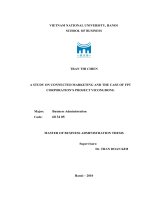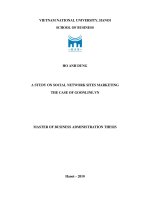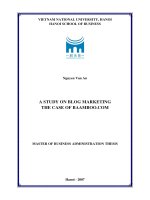A study on blog marketing the case of baamboo com
Bạn đang xem bản rút gọn của tài liệu. Xem và tải ngay bản đầy đủ của tài liệu tại đây (891.23 KB, 84 trang )
vietnam national university, HANOI
hanoi school of business
Nguyen Van An
A STUDY ON BLOG MARKETING
THE CASE OF BAAMBOO.COM
Master of business administration thesis
Hanoi - 2007
vietnam national university, HANOI
hanoi school of business
Nguyen Van An
A STUDY ON BLOG MARKETING
THE CASE OF BAAMBOO.COM
Major: Business Administration
Code: 60 34 05
Master of business administration thesis
Supervisors: dr. nguyen viet anh
Hanoi – 2007
A study on blog marketing – The case of Baamboo.com
Table of content
INTRODUCTION ........................................................................................................................................... 6
1.
The problems .......................................................................................................................................... 6
2.
Objectives and Aims............................................................................................................................... 6
3.
Research questions ................................................................................................................................. 7
4.
Scope of work.......................................................................................................................................... 7
5.
Data sources ............................................................................................................................................ 8
6.
Methods ................................................................................................................................................... 8
7.
Significance ............................................................................................................................................. 8
8.
Limitation................................................................................................................................................ 8
9.
Expected results ...................................................................................................................................... 9
10.
Outline ................................................................................................................................................ 9
CHAPTER ONE: THEORETICAL FOUNDATION ................................................................................ 10
1.
2.
3.
Blogging basic ....................................................................................................................................... 10
1.1.
Blog definitions ............................................................................................................................. 10
1.2.
Types of blog ................................................................................................................................. 11
1.3.
Common blog elements ................................................................................................................. 14
Business blog ......................................................................................................................................... 15
2.1.
Power of blog to business ............................................................................................................. 16
2.2.
Types of business blog .................................................................................................................. 17
2.3.
Business blog format..................................................................................................................... 19
Steps in business blogging .................................................................................................................... 19
3.1.
Step 1: Choosing to blog or not .................................................................................................... 19
3.2.
Step 2: How many blogs needed and how often to maintain them ................................................ 20
3.3.
Step 3: Selecting a Software System or Service ............................................................................ 20
3.4.
Step 4: Design for readers ............................................................................................................ 21
3.5.
Step 5: Publishing Blog ................................................................................................................ 21
3.6.
Step 6: Launching Blog and Getting Noticed ............................................................................... 21
1
A study on blog marketing – The case of Baamboo.com
3.7.
4.
5.
Step 7: Monitoring and Managing Blog ....................................................................................... 22
Marketing with blog ............................................................................................................................. 22
4.1.
Talking with customers ................................................................................................................. 23
4.2.
Raising awareness and visibility ................................................................................................... 24
4.3.
Closing sales ................................................................................................................................. 26
4.4.
Dealing with disasters .................................................................................................................. 28
4.5.
Building reputation and recognition ............................................................................................. 29
Blog marketing performance .............................................................................................................. 29
5.1.
Key performance indicators.......................................................................................................... 29
5.2.
Common KPI of blog .................................................................................................................... 30
5.3.
Analysis method ............................................................................................................................ 35
CHAPTER TWO: THE CASE OF BAAMBOO BLOG ............................................................................ 37
1.
Introduction to Baamboo ..................................................................................................................... 37
2.
Baamboo blog structures ..................................................................................................................... 37
3.
4.
5.
2.1.
Baamboo blog ............................................................................................................................... 38
2.2.
Baamboo blog design ................................................................................................................... 38
2.3.
Main features ................................................................................................................................ 40
2.4.
Additional features........................................................................................................................ 43
The use of blog as a marketing tool .................................................................................................... 45
3.1.
Interacting with users ................................................................................................................... 45
3.2.
Analyze comments and react......................................................................................................... 47
3.3.
The Baamboo mp3 example .......................................................................................................... 49
3.4.
Findings ........................................................................................................................................ 53
Baamboo blog performance analysis .................................................................................................. 54
4.1.
Analysis objectives ........................................................................................................................ 54
4.2.
The data source............................................................................................................................. 55
4.3.
Performance results ...................................................................................................................... 55
4.4.
Findings ........................................................................................................................................ 67
Conclusion ............................................................................................................................................. 68
CHAPTER THREE: SOLUTIONS TO IMPROVE BAAMBOO BLOG ............................................... 69
1.
Content solutions .................................................................................................................................. 69
1.1.
Building comment policy .............................................................................................................. 69
1.2.
Improve entries content quality .................................................................................................... 73
1.3.
Improve Blog design, layout ......................................................................................................... 75
2
A study on blog marketing – The case of Baamboo.com
2.
Marketing solutions.............................................................................................................................. 76
2.1.
Continuous interactions ................................................................................................................ 76
2.2.
Attracting new visitors .................................................................................................................. 78
REFERENCES .............................................................................................................................................. 82
3
A study on blog marketing – The case of Baamboo.com
List of figures
Figure 3-2 Baamblog interface ............................................................................................ 39
Figure 3-3 Place to comment on Baamblog entry ............................................................... 42
Figure 3-4 Baaamblog comments example ......................................................................... 42
Figure 3-5 Comment form ................................................................................................... 43
Figure 3-6 Poll example ....................................................................................................... 44
Figure 3.7 Five steps of analyzing comments...................................................................... 47
Figure 3.8 Baamboo Mp3 light version interface ................................................................ 52
Figure 3.9 Source stability measurement function ............................................................. 53
Figure 3.10 Traffic sources .................................................................................................. 57
Figure 3.11: Percent of Unique Visitors Growth this Period ............................................... 58
Figure 3.12 Percent of Traffic Growth this Period .............................................................. 58
Figure 3.13 Percentage of New visitors ............................................................................... 58
Figure 3.14 New vs. Returning visitors ............................................................................... 59
Figure 3.15 Page Bounce Rate ............................................................................................. 60
Figure 3.16 Percentage of Returning Visitors ..................................................................... 61
Figure 3.17 Growth of returning visit .................................................................................. 61
Figure 3.18 Percentage of loyal visitors .............................................................................. 62
Figure 3.19 Number of commnents ..................................................................................... 63
Figure 3.20 Average pageview for all visitors ..................................................................... 63
Figure 3.21 Average Time Spent on Site ............................................................................. 64
Figure 3.22 Percent of Visits Greater than 180 Seconds ..................................................... 65
Figure 3.23 Percent of Committed Visits (> 2 page views per visit)................................... 66
4
A study on blog marketing – The case of Baamboo.com
List of table
Table 3.1 Baamboo blog entries contents ............................................................................ 41
Table 3.2 Numbers of comments by entries on Baamboo blog ........................................... 42
Table 3.3 Baamboo Mp3 comments categories and subcategories ..................................... 51
Table 3.4: Part of Baamboo Mp3 comments list after categoried ....................................... 51
Table 3.5 Baamblog key performance indicators from June to September ......................... 56
Table 3.6 Percentage of bounce rate for new and returning visitors ................................... 60
5
A study on blog marketing – The case of Baamboo.com
INTRODUCTION
1.
The problems
Nowadays, blog or weblog has become a phenomenon. In recent years,
millions of blogs have appeared and the growth of blog seems not to
slowdown. Many companies have used blogs for their marketing activities
and many of them have obtained successes. Microsoft, General Motors,
Disney are typical examples. Besides, thousands of small and medium
companies also succeeded in using blog marketing.
In Vietnam, this trend has just been raised for one or two years.
However, the effectiveness of using blog as a marketing tool is still
problematic. Vietnam Communication Corporation is one of the leading
companies who first use blog for their service – baamboo.com. Although,
some results have been gained, this company is getting stuck of finding ways
use blog marketing professionally.
The thesis ―A study on blog marketing – the case of Baamboo.com‖
aimed to study blog marketing and propose solutions to improve the use of
blog for the Baamboo.com service of Vietnam Communication Corporation.
2.
Objectives and Aims
The objectives of this thesis is to study
The basic concept of blogs and business blogs
The use of blogs in marketing
The use of blog as a marketing tool at Baamboo.com
Problems of Baamboo in using blog marketing and solutions to improve
these
6
A study on blog marketing – The case of Baamboo.com
With these above objectives, this thesis aims at giving a basic theoretical
foundation for other companies in general, and internet companies in
particular to implement blog marketing for their business activities.
3.
Research questions
The complete list of research questions is as follows:
What are definition, type, common features of blog and business blog?
Why is blog important to business?
What are steps in blogging?
How blog is used in marketing?
How to measure blog marketing performances?
What has the Baamboo blog done so far?
What are Baamboo blog‘s results?
What are Baamboo blog‘s problems?
What are solutions to improve Baamboo blog performances?
4.
Scope of work
For the theoretical foundation, this thesis will study the blog theory in
the world of internet companies since 2005 when blog became a worldwide
phenomenon.
For the case study, this thesis will choose the first area of blog marketing
– taking with customers – to study because this is the most popular area that
exists in Vietnamese internet services industry now. Baamboo blog case
currently applies in that area thus is picked up. All of its activities from
establishment on 8th June, 2007 until now are put into study.
7
A study on blog marketing – The case of Baamboo.com
5.
Data sources
For the theoretical part, data sources are textbooks, articles from internet
since 2005. As for the case study, data is obtained from interview with
Baamboo team and internal data, which are being tracked by Google
Analytics.
6.
Methods
The thesis uses the empirical method, interview and case study in the
study process.
7.
Significance
The thesis may contribute a small part to the development of internet
industry, which has been emerging in Vietnam. Since the forecast of internet
booming in Vietnam in next two or three years, many companies can
implement the knowledge studied in this thesis for their business activities.
8.
Limitation
The biggest limitation of this thesis is due to the freshness of internet
services industry in Vietnam in general, and blog in particular, therefore few
academicals reviews have been applied and proved. In case of the Baamboo
blog, it has just run for four months, so it may be early to measure and judge
its marketing performance.
The other limit is from case study method. This method cannot cover all
the theoretical issues of blog marketing. Thus, later this case, this thesis only
studies one out of five areas in blog marketing and applies some related key
performance indicators to analyze performance for the Baamboo blog.
8
A study on blog marketing – The case of Baamboo.com
9.
Expected results
The thesis expects to give the systematical theory in blog marketing, find
out Baamboo blog performance shortcomings and proposes solutions to
improve it.
10.
Outline
Excluding introduction, conclusion and reference part, this thesis
includes three parts as follows:
Chapter 1: Theoretical Foundation
Chapter 2: The case of Baamboo blog
Chapter 3: Solutions to improve Baamboo blog
9
A study on blog marketing – The case of Baamboo.com
CHAPTER ONE:
THEORETICAL FOUNDATION
1. Blogging basic
During the past few years, blogs have become a worldwide cultural
phenomenon. The number of blogs has been increasing exponentially.
Technorati, a blog search site, say that they are now tracking 96.9 million
blogs all over the world1. In addition, in their ―State of the Blogosphere‖
report in October 20062, Technorati gave some conclusion about the number
of blogs:
Today, the blogosphere is doubling in size approximately every 230 days.
About 100,000 new weblogs were created each day
Businesses also begin to appreciate the power of blogs, a trend reflected
in the business press. In its January 2005 issue, Fortune put blogs at number
one in its '10 Tech Trends to Watch for', arguing that blogs are changing
working practices in the areas of advertising, marketing and PR (Kirkpatrick
& Roth, 2005). Similarly, The Harvard Business Review named blogs as one
of its ―Breakthrough Ideas for 2005‖, commenting that ―blogs are the most
conversational of all the forms of media, and marketers can't afford to be left
out of the talk‖ (Sawhney, 2005).
1.1.
Blog definitions
Blog is not a new word though its history is still short. Jeremy Wright
(2006)3 has listed a number of blog terms:
1
Source />Source />3
Jeremy Wright (2006), Blog Marketing, the revolutionary new way to increase sales, build your brand, and
get exceptional results, McGraw Hill , page 7.
2
10
A study on blog marketing – The case of Baamboo.com
Blog A website comprising blog posts or content written by the blogger,
which are typically organized into categories and sorted in reverse
chronological order. Most blogs allow readers to comment on individual
blog posts.
Blog posts or blog entry Individual items posted to the blog (using
blogware) by the blogger.
Blogger The individual who maintains the blog and/or writes blog posts
using the blogware.
Blogosphere The community of blogs, bloggers, and blog posts.
Blogware Software used to create blog posts and manage blogs.
The conversation What happens when bloggers, especially millions of
them, blog.
Permalinks Permanent links attached to a particular blog post that
remains unchanged.
Trackbacks URLs that other bloggers use to cite posts or parts of posts;
for example, when you, Blogger A, write about something Blogger B
posted on in her blog, it is best to let Blogger B know she has been
mentioned in your blog. Trackbacks send Blogger B an e-mail with a
notation that her blog has been cited.
1.2.
Types of blog
Blog have many types depending on how we categories. Here are five
common types of blogs.
11
A study on blog marketing – The case of Baamboo.com
1.2.1.
General Blogs
This kind of blog is general when people say ―blog‖. These blogs are
generally text-based, but contain a lot of images and other media like for their
simplicity.
1.2.2.
Photo Blogs
Photoblogs, also called Phlogs are special kind of blogs where a group of
people or individuals share their photos collected from various sources. In
photoblogs, images are the main content; we all know that a picture speaks a
thousand words. The usual subjects of photoblogs are films, wars, herbs,
natural beauty, or even weird images, and so forth; it is impossible to specify
all of them.
These blogs are generally dedicated towards a specific audience such as
photographers, artistes, etc. Most photoblogs are free. And most of photobloggers use popular image-sharing service to share their photos. We can list
out many popular images sharing service such as Flickr (www.flickr.com),
SmugMug
(),
or
Zoomr
(www.zoomr.com),
PicasaWeb ().
1.2.3. Mobile Blogs
Mobile blogs are often known as Moblogs. In this type of blogs, people
access the contents and modify them for their mobile phones or portable
devices like PDAs. Mobile blogs are very popular these days due to the
availability of portable devices. Moblogs are usually developed in Japan
where people have a huge number and variety of portable devices with
cameras. Mobile blogs are often known as gLogs (pronounced as glogs),
when they are especially used as photoblogs.
12
A study on blog marketing – The case of Baamboo.com
1.2.4.
Audio Blogs
Audio blog are blog, whose contents are downloadable in audio format4.
In this kind of blog people usually use mp3 format due to the popularity of
this type. Beside most audio blogs are devoted to a special genre of music like
rock, classic, or jazz.
According to Wikipedia, many music bloggers publish content that may
violate copyright laws. However, sometimes they manage to avoid it, since
most of their contents are either old or not reissued recently and so may not
cause monetary damage for the copyright older. Many audio bloggers also
place a notice in their blogs like "If the owner objects about this post, I will
immediately remove it from my blog". Many commercial music companies
also maintain audio blogs and publish their music files as an advertisement to
gain popularity.
1.2.5.
Video Blogs
Video blog is often known as vlogs. It is similar to audio blogs except
for the type of content they serve.
Vlogs become popular these days after the marketing of Apple's iPod or
iTune. In the iTune community, video blogging is often known as "video
podcasting". Some important facts from vlog history include: Yahoo's vlogger
community grew to more than 1000 members in June, 2005; Apple declared
that its iPod will play video files; and, Apple's iTune store will also serve
videos. These days VlogMap.org shows vloggers from around the world with
the help of Google Earth and Google Maps.
4
Audio format include mp3 (the most popular format), wma, aac, ogg, etc.
13
A study on blog marketing – The case of Baamboo.com
1.3.
Common blog elements
Blog differs in structure depending on what blog service used. However,
they still have common elements in structures. Each blog has not only
chronological entries and archives but also the following5:
Author byline - A byline above (or below) each entry is less important in
personal blog than in-group blogs. Still, many blogs carry that byline as a
default setting in the blog software.
Permalink - Short for ―permanent link,‖ this link takes the visitor from
the index page to the entry‘s unique page.
Blogroll - The blogroll is not a requirement, but it is a tradition to list the
blogger‘s favorite blogs in a sidebar. The blogroll is usually common to every
page of the blog, so visitors can see favorite blog destinations no matter where
they enter that blog. Blogrolls make the blogosphere somewhat incestuous,
with many topical blogs all linking to each other. Having one‘s blog included
in a high-profile blogroll is an honor and can deliver lots of traffic to a
previously little-known blog.
Categories - Some blog programs allow the blogger to assign categories
to blog entries. These categories are listed in a sidebar, so that visitors can
restrict their reading to a category of interest. It is not unusual for one entry to
be tagged in multiple categories.
Comments - Comments are written by visitors to blog and are presented
below blog entry. On the index page, a Comments link sends visitors to that
unique page, scrolled down to the first comment. Many blog programs allow
the comments function to be turned off, so visitors cannot talk back. Some
blog experts believe that the presence of comments is a defining feature of a
5
Source: Brad Hill (2006), Blogging for Dummies Blogging For Dummies , Wiley Publishing, pages 20 - 23
14
A study on blog marketing – The case of Baamboo.com
Weblog. Comments are a crucial part of what is called the macrologue — farflung group discussions across many blogs.
TrackBacks - TrackBacks are related to comments but are trickier to
understand. For now, know that TrackBacks offer a way to put a link to blog
entry on someone else‘s blog. TrackBacks link blogs together in the
macrologue.
Syndication link - A final element common to most blogs is the
syndication link, which can take several forms and is worthy of a thorough
discussion. The take-away point for now is that many people read blogs in
newsreaders, not by visiting the blog sites. Newsreaders pull the content of
many blogs into one window. Within a newsreader, each blog is called a feed.
These newsreaders are mostly free and can be standalone programs that can
be downloaded to computers or Web-based services.
Making blog‘s content available as a feed is crucial. Fortunately, this
fairly technical method of distributing blog entries is effortlessly handled by
nearly all blog software. Using RSS and other syndication formats has
become so simple that this book does not spend any space explaining how to
create syndication links from scratch.
2.
Business blog
From the beginning of blog history, many people know how to used blog
for their business. The business blog, or corporate blog, is a relatively new
experience. A business blog will contain the more ―human‖ side of what is
happening in the business, to show that rather than just being an entity with a
sole purpose of making money there is a more "responsible" side to the
business. Business blogs are all about opening up companies‘ knowledge,
expertise, processes, and goals to their customers.
15
A study on blog marketing – The case of Baamboo.com
2.1.
Power of blog to business
Though the history of blog is rather short, many companies have tried to
use blog in their business. Blog seems to be a power tool. The core needs of
blog for any business are as follows:
2.1.1.
Create ideas:
Every company has great ideas waiting to come to the surface. However,
from ideas to activities is still a big gap. Many ideas can be harmful to
companies if they are not carefully evaluated. Moreover, it cost lot of human
resource for any ideas. Even a great idea is generate by one person, it still
need 100 or more people to support and implement. So blogging can help so
that problem. A truly open and internally viewable idea blog, or even
individual employee blogs that allow people to float new ideas for peer
review, should allow the best ideas to rise to the surface for selection and
review.
2.1.2.
A great product
One of big challenge of companies is getting ideas turned into product.
This put a very hard job to their product manager
With blogging, companies can ask—if not the entire world, then at least
their entire blog readership, who are probably connected to and/or reading
other blogs from all over the planet. Once they have insight into what a large
community of readers wants, they can begin delivering it. They must know
customers, know the market, and know how to deliver new products on time
and on budget. Usually, they use techniques like focus groups, customer demo
days. These techniques have a big drawback due to the small sample of
customers. Blog can solve that problem. With blogging, companies or product
managers can ask—if not the entire world, then at least their entire blog
16
A study on blog marketing – The case of Baamboo.com
readership, which are probably connected to and/or reading other blogs from
all over the planet. Once companies have insight into what a large community
of readers wants, they can begin delivering it.
2.1.3.
Visibility
Marketing is all about visibility—making the right people aware of the
right product at the right time. Companies often use campaigns to attract to
mass of customer. They assume that millions of people will be contacted, but
only a small percentage of these people will respond. This method of
marketing has its upside, but it does not do anything to create relationships
with customers, create positive experiences, or create customer evangelists.
This is where blog can be useful to companies.
Blog create new methods of effective marketing include creating ―viral‖
campaigns, customer-centric events, and otherwise helping customers spread
the word through incentive programs and contests. Readers can decide how
and when to interact with companies. Not only do companies give them
control over the relationship, but also companies encourage them to continue
to engage over time, thus providing a multitude of experiences they can
subsequently share with friends and associates. Customers are encouraged to
become participants and participants to become evangelists. Then, they
encourage everyone to come together as a community.
2.2.
Types of business blog
Companies can choose of many type of blog to create. Let us explore
each type one by one.
17
A study on blog marketing – The case of Baamboo.com
2.2.1.
Company Blogs
A company blog is about its business in general; it works like a brochure
site, but with a blog for news, announcements, and other fresh content. It is
typically limited to content about the company itself. Normally, it is an
official blog, in which updates information of company, products, activities
2.2.2.
Product Blogs
A product blog specifically promotes an item or service. Product blogs
may overlap with brand blogs, but their primary purpose is to promote and
sell. These blogs also give readers the most up-to-date information of product,
the prospect of development, new features, etc.
2.2.3.
Brand Blogs
A brand blog is used to communicate marketing messages and extend a
company's brand into new markets and audiences. Some brand blogs are set
up as sponsored blogs written by people outside the company. Many famous
companies such as Boeing, GM Fastlane, Microsoft, and Sun have published
brand blogs.
2.2.4.
Staff blog
Many encourage their staff to write blog about company, cultures,
products, etc. Staffs are let free to talk whatever they want about companies‘
products and services but companies always keep close eyes on their
member‘s activities in order to prevent scandals or bad effects from that.
18
A study on blog marketing – The case of Baamboo.com
2.3.
Business blog format
Since the use of blog is different, business blog also differ in its format.
Normally, a good blog format contains a combination of these elements 6:
Name: short, catchy, and humorous phase expresses the blog name
The latest post: The date, and occasionally the time, display so that reader
know which entry is the latest one. Unlike the front page of most business
Web sites, a blog home page is usually quite long, because older entries
also display on the home page.
Comment link: After each entry, most bloggers invite the reader to add a
comment.
A collection of related info: This element is often on the right- or lefthand side of the browser window. This info may consist of e-mail
subscription opportunities, explanatory or biographical information,
archived entries, and links to other blogs that the blogger reads regularly
and recommends.
3.
Steps in business blogging
3.1.
Step 1: Choosing to blog or not
In this early stage, companies should answer the question whether they
create blog or not. Blog is not a relax game but a part of business. To success
in blogging, the companies have to pay time, efforts and human resources. If
the answer is positive, companies should define goal and plan a strategy for
blogging.
6
Susannah Gardner (2005), Buzz Marketing with Blogs For Dummies, Wiley Publishing, page 13
19
A study on blog marketing – The case of Baamboo.com
3.2.
Step 2: How many blogs needed and how often to maintain them
There are some levels of using blogs as a tool for bussiness marketing.
They are basic blogs, full-time blogs, and companywide blogs. The higher
levels, the more resources the company have to use.
At the basic blogs level, a minimal presence with a free or inexpensive
blog account on a hosted service like Blogger, TypePad, or Blog Harbor is
needed to set up and have someone post as little as three to four times a week.
For a full-time blog, one dedicated person involved, or a team of people
contributing to the site.
At this highest level, companies have taken the ultimate plunge and are
empowering all employees to blog.
Therefore, in this step, companies must decide the resource needed for
business bloggers. Depending on the size of companies and their strategy in
using blogs, they can decide whether they need just one blog (for small
companies) or many blog (usually for big companies). They also have to
consider putting a fulltime team or person on it or just assigning one part-time
staff to manage blog. Lastly, they should consider to post on blog regularly or
occasionally.
3.3.
Step 3: Selecting a Software System or Service
In this step, companies have to decide they should use blog services
provided by other companies, i.e. Blogger, Wordpress, Typepad, etc., or set
up their own blog site. Using a blog service has many advantages: Blogging
quickly, easily, and free from a lot of technical hassles. However, it also
brings many inconveniences, for examples – customization, statistics, and sub
domain that are benefits of installing a system for blogging. Besides,
20
A study on blog marketing – The case of Baamboo.com
requirement of installation, configuration, administration, customization, and
support may prevent companies from blog.
3.4.
Step 4: Design for readers
In this step, companies have to decide which features should be used,
what structural and visual design to choose in order to allow them to develop
a richer conversation with their readers. They also consider how to make good
design choices by concentrating on simplicity and ease of use.
For the features, they should choose among essential features (meta
information, entries, categories, tag, RSS, email notification) and advance
ones (comments, track back, search, calendar, survey, etc). Each feature
brings not only certain benefits but also drawbacks.
For the design, depend on the blog focus, they should answer such
questions as: What page layout to use? What goes where? How do they
change the layout and how much time for each change? Etc.
3.5.
Step 5: Publishing Blog
In this step, companies have to decide how to publish their blog. It is not
only the problems of service or system used. Companies have to choose
whether use a blog-posting program or do it manually. Other decision to make
is how to post audio, video and photo on their blog.
3.6.
Step 6: Launching Blog and Getting Noticed
In this step, companies have to decide how to promote blog, how to
make it interesting to attract new readers, visitors. After that, they should
know how to make conversations going, how to make blog easily found by
search engines, how to make blog spread out widely.
21
A study on blog marketing – The case of Baamboo.com
3.7.
Step 7: Monitoring and Managing Blog
This step is never end. Companies should keep track on blog traffics.
They can use many tool such as Urchin to monitor or use service to compares
such as Alexa. They also have to discover trends of visitors, behaviors, etc
based on the statistics they have from blog log data or such services as
Google, Technorati, and BlogPulse.
Moreover, they have to manage comments and conversation on blog,
know when to let go and manage possible and potential crisis before it may
happen.
4.
Marketing with blog
Almost all businesses dedicate significant resources to understanding
their market and spreading the word about their company and the products
they offer. For many successful organizations, blogging has provided a crucial
way to raise that awareness. Besides, the Web is a critical channel for
marketing and selling products and services. For many, blogs that focus on
selling products are proving effective at generating revenue. Taking care of
current customers is good business. It is been well documented that one of the
best resources a business has for driving future sales is their current customer
base. According to Fredrick F. Reichheld, director of the strategy-consulting
firm Bain & Company, a 5-percentage-point increase in customer retention in
a typical company will increase profits by more than 25 percent. In addition,
satisfied customers drive positive word of mouth buzz, which can strongly
influence new customers. Blogs are proving to be a great way to support
customers after they have bought (and before they buy again)7. Lastly,
7
DL Byron, Steve Broback, New Riders (2006), Publish and Prosper: Blogging for Your Business, chapter 2
22
A study on blog marketing – The case of Baamboo.com
reputation and recognition of companies can be enhanced in company with
the visibility of their blog.
This thesis mentions these five focus areas in blog marketing which are
discussed in more depth below.
Blogs that help talking with customers
Blogs that raise awareness and visibility
Blogs that sell products
Blogs that support current (and prospective) customers
Blogs that build reputation and recognition
4.1.
Talking with customers
Encouraging an interactive audience
Blog enables companies to interact more directly with new, existing, and
potential customers by giving them easy ways to talk with them, stay in touch
and be alerted whenever they post something new. This exchange allows them
to increase their awareness and to sell product directly. Dialog also allows
companies to learn more about what their market wants because customers
will tell what they want right in their blog.
As a marketing tool, blogs are used by companies to enable "virtual
focus group" of customers. Blog will be a place where companies listen and
respond to comments and then use that feedback to improve their products
and support.
To get this type of focus group feedback, companies often enable
comments on their blog, post about their product, and then ask for input.
Usually, blog will encourage lots of comments and reader participation.
Companies then have to authorize comments, eliminate inappropriate
contribution and make sure the site‘s authors are participating in the
23









